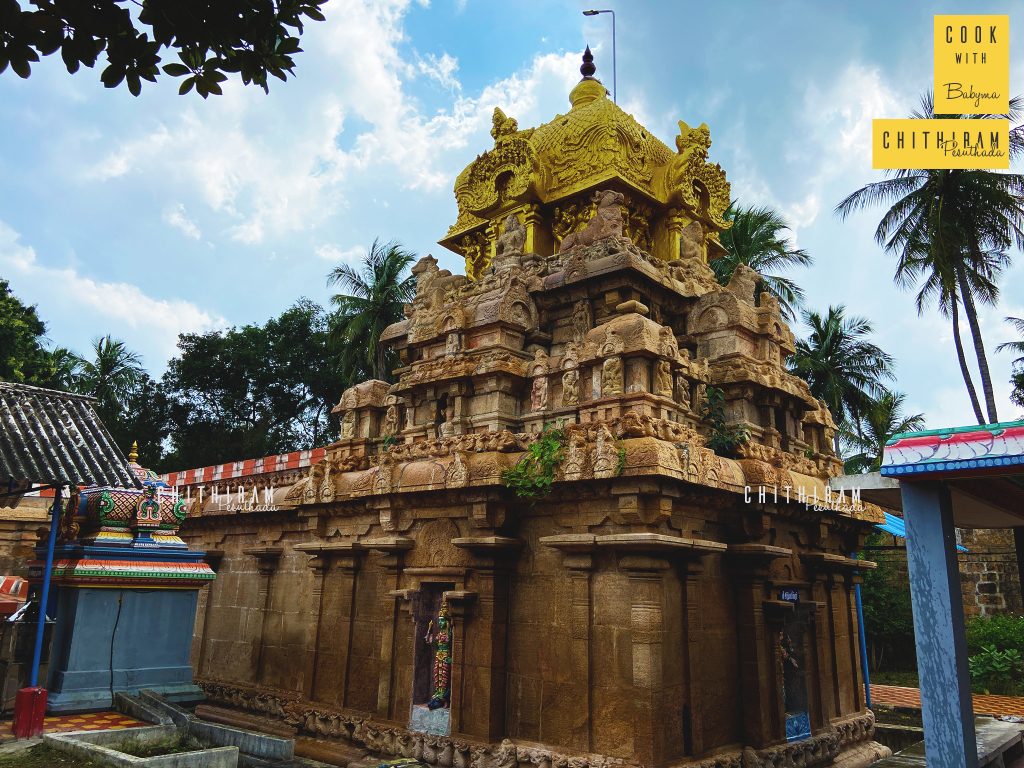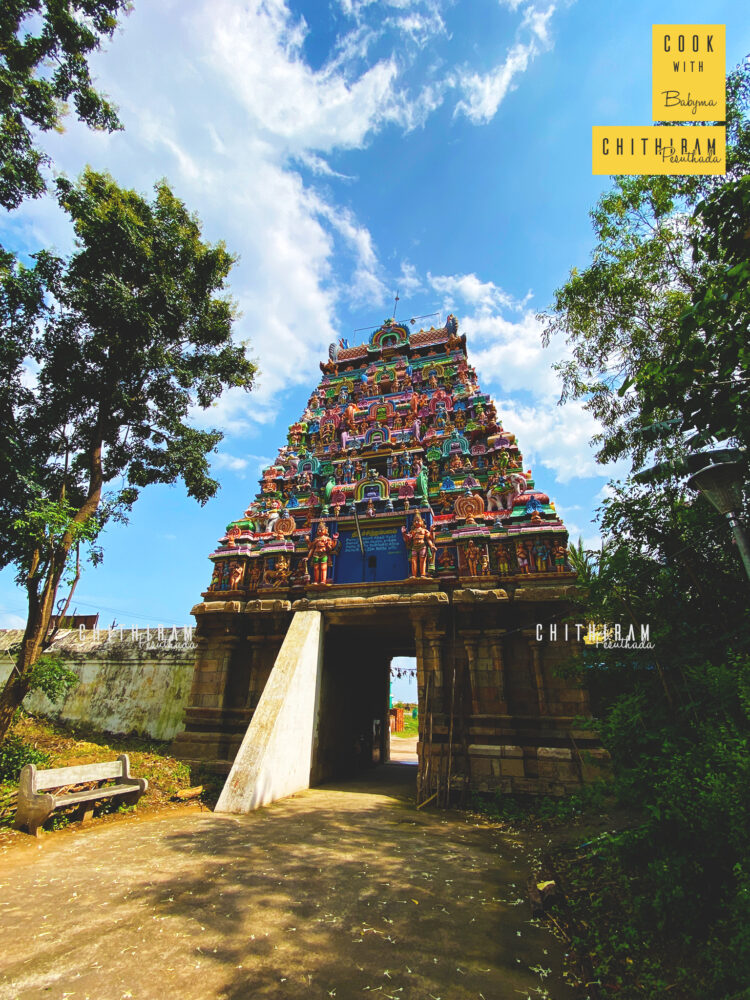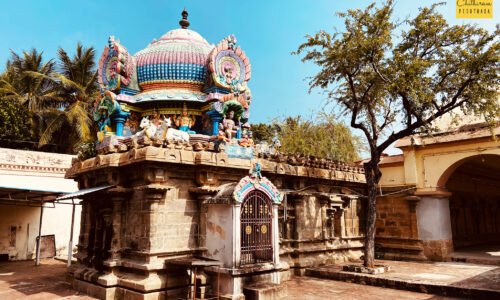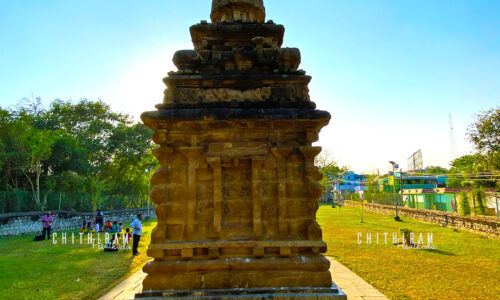இன்று திருச்சி மாவட்டத்தில் அமைந்துள்ள திருச்சி கரூர் செல்லும் சாலையில் காவிரிக்கரையின் மேல் இயற்கையான சூழ்நிலையில் அமைந்துள்ள இந்தக் கற்கோவில் கி.பி. ஒன்பதாம் நூற்றாண்டை சேர்ந்த சோழர் காலத்து திருச்செந்துறை “மானேந்தியவல்லி உடனுறை சந்திரசேகர சுவாமி திருக்கோவிலை”-த்தான் இன்று பார்க்கப் போகிறோம்!
முதலாம் பராந்தகச் சோழனின் மருமகளும், அரிகுல கேசரியின் மனைவியான இருக்குவேளிர் குலத்தேவியான “பூதி ஆதித்த பிடாரி” என்னும் சோழப் பேரரசியால் இக்கற்றளி கட்டமைக்கப்பட்டது.
கிழக்கு நோக்கி அமைந்த இக்கோவில், ஐந்தடுக்கு ராஜகோபுரத்தில் உள்ள சுதை சிறப்ங்கள் ஒவ்வொன்றும் தனித்துவமானது.
இதை கடந்து உள்ளே சென்றால் ஒரு பெரிய பிரகாரத்தின் இடையில்
கொடிமரம் இல்லாமல் நந்தி தேவர் ஒரு தனி மண்டபத்திலும், பலிபீடமும் பார்க்க முடிகின்றது. எளிமையான வாசலை கடந்து உள்ளே சென்றால் அழகிய தூண்களுடன் கூடிய இன்னொரு பிரகாரம் நம்மை இனிதே வரவேற்கின்றது.

இரண்டு தளங்களுடன் கூடிய நாகர வகை விமானத்துடன், கருவறை, அர்த்தமண்டபம், முன் மண்டபம், மகா மண்டபத்துடன் அமையப்பெற்ற இக்கோவில் செம்புரான் கற்களினால் கட்டப்பெற்ற ஒரு அழகிய கற்றளி.
சொல்ல போனால் அந்தி சாயும் நேரத்தில் தங்கம் போல் ஜொலிக்குமாம் இந்த கோவில்!
இக்கோவிலானது பிரதிபந்தம் கட்டுமான அமைப்பில் கட்டப்பெற்றுள்ளது. மகாபத்மம், உருள் குமுதம், யாளி முதலான உறுப்புகள் இங்கே எழில் மிக்கதாய் காண முடிகின்றது. கட்டிட கலையின் நுணுக்கங்களையும், கல்வெட்டின் செய்திகளையும் காணொளியில் முடிவில் காணலாம்.
தெற்கு கோட்டத்தில் நந்தியின் மேல் சாய்ந்தவாறு ரிஷபாந்திகர் காணப்படுகிறார். கால ஓட்டத்தினால் திருமேனி சிதைவுற்று இருந்தாலும், இன்னும் சிலையின் உயிரோட்டத்தை காணமுடிகின்றது.
ரிஷபாந்திகர் முன்பு புதிதாக கட்டப்பெற்ற தக்ஷிணாமூர்த்தியின் சன்னதி பார்க்க முடிகின்றது. இவரை கடந்து சென்றால் தென் மேற்காக இரண்டு சன்னதிகள் காண முடிகின்றது. அதில் காசி விஸ்வநாதர் விசாலாட்சிக்கு தனி சன்னதி காண முடிகின்றது. இதன் பின்புறம் நிருதி விநாயகருக்கு இன்னொரு தனி சன்னதி பார்க்க முடிகின்றது.
கருவறை தெற்கு கோட்டத்தை தவிர மற்ற கோட்டத்தில் சோழர் கால திருமேனிகள் இல்லாமல் புதிதாக அமைக்கப்பெற்ற சுதை சிற்பங்கள் காண முடிகின்றது.
மேற்கில் அர்த்தநாரீஸ்வரர் திருஉருவம் காண முடிகின்றது. மேற்கு கோட்டத்திற்கு நேர் எதிரே வள்ளி சுப்ரமணிய தெய்வானை சன்னதி காண முடிகின்றது. கோவிலின் தலமரமாக பலாமரம் இங்கே பசுமையாக காணப்படுகிறது.
கருவறை வடக்கு கோட்டத்தில் துர்கையின் திருவுருவம் காண முடிகின்றது. பொதுவாக இவ்விடத்தில் நான்முகன் இருக்க வேண்டும், காரணம் க்ரீவ கோட்டத்தில் இங்கே நான்முகனின் சிற்பம் காண முடிகின்றது. வடக்கில் விஷ்ணு துர்க்கைக்கு ஒரு புது சன்னதி இங்கே கட்டமைக்கப்பெற்றுள்ளது. ஒரு தனி சன்னதியில், சோழர் காலத்து சண்டிகேஸ்வரர் இங்கே காண முடிகின்றது.
இன்று மக்களால் சந்திர சேகர சுவாமி என்று அழைக்கப்படும் மூலவருக்கு திருச்செந்துறை உடையவர், பரமேசுவரர், கற்றளி பெருமானடிகள் போன்ற பெயர்களும் வழங்கப்பட்டுள்ளன. அம்பாள் இங்கே மானேந்தியவல்லி உருவாக நமக்கு அருள் புரிகிறாள். இங்கு அம்மன் மானும் மழுவும் கையில் ஏந்தி நிற்கிறாள்.
இக்கோவிலின் கல்வெட்டின் மூலமாக, இவ்விடத்தை ‘உறையூர் கூற்றத்து பிரம்மதேயம் ஈசானமங்கலம்’ என்று ஒரு கல்வெட்டு கூறுகிறது.
இக்கோவிலில் ராஜகேசரி, பரகேசரி, மதுரைகொண்ட பரகேசரி, முதலாம் ராஜேந்திரன், முதலாம் குலோத்துங்கன், விக்ரம சோழன், இரண்டாம் ராசராசன், இரண்டாம் ராஜாதிராசன், விஜயநகர அரசன் ஸ்ரீரங்கமகாதேவர் ஆகியோர் காலத்திய கல்வெட்டுகள் இங்கே காணமுடிகின்றது.
ஒரு சோழப் பெண்ணரசியால் தோற்றுவிக்கப்பட்ட இக்கோவில் இன்றும் நம் கண்முன்னே கம்பீரமாக நிற்கின்றது.
நேரம் கிடைத்தால் நீங்களும் நேரில் சென்று காணுங்கள், அடுத்து இன்னொரு காணொளி தொகுப்போடு உங்களை சந்திக்கின்றேன், நன்றி! வணக்கம்!
Sri Chandrasekhara Swamy Temple
Maanendiya Valli samedha Sri Chandrasekhara Swamy Temple, Tiruchendurai (aka) Jeeyapuram, Tiruchirappalli District, Tamil Nadu.
God: Chandrasekhara Swamy | Mrityunjayeswara Murti | Katrali Perumaanadigal | Tiruchendurai Udaiyavar | Parameshwarar
Goddesses: Maanendiya Valli | Mrigadharambika
Location: https://goo.gl/maps/WoHATYzuVhwCnVA29
YouTube: https://www.youtube.com/c/chithirampesuthada
Facebook: https://www.facebook.com/chithirampesuthadasuresh
Instagram: https://www.instagram.com/chithirampesuthada/
Flickr: https://www.flickr.com/photos/chithirampesuthada/
Web: https://chithirampesuthada.com/
This Temple is one of the Thevara Vaippu Sthalams sung by Sri. Thirugnanasambandar, but the Paadal was lost. Tiruchendurai is known as Jeeyapuram nowadays.
The east-facing Chandrasekhara Swamy Temple has a five-tiered Rajagopuram. The Rajagopuram has a lot of stucco figures, and in that, some of them are unique and interesting. There is a vast area between the Rajagopuram and the Temple’s superstructure. Nandi Mandapam and Bali Peeta face towards the Sanctum.
The Chandrasekhara Swamy Temple supposedly houses a Shiva lingam shaped like a Jackfruit, and the Sthala Vruksham is also a Jackfruit tree with fruits from the branches and the roots. There are two minor Trishula signs in Ishana direction and Agni direction on this Siva Linga. The Goddess is called Maanendiya Valli, and in Sanskrit, she is called Mrigadharambika. Her shrine is facing the southern direction. The sub-shrines of Ganesha, Vishwanathar and Subramanya-Valli-Devasena are located in the Prakara.
The Vimana is entirely built with Laterite stone and has two tiers. There are excellent idols in the second tala, Dakshinamurthi in the south, Vishnu in the West, Brahma in the north, and beautiful small figures of adorers. At the entrance of Ardha Mandapa, two big and beautiful Chola period Dwarapalas are found. In Maha Mandapam, Nandi is found facing the Sanctum.
The outer wall of the Sanctum (south side) has the beautiful niche idol of the Chola period Vrushabhantika Murti (Rishabanthigar). The other two niches do not have the original Murtis. The initial Chola period Chandikeswara is found in the Temple. The Chola period icons of Surya and Bhairava are found facing the Sanctum.
Legends:
Parantaka Chola camped along with his army to destroy the bandits residing in this region, a forest full of jack trees in those days. However, he could not find any bandit here. But, he found a lot of deer in the woods, and the King desired to hunt the deer. When he was chasing a deer, it went inside a bottomless pit. The King released an arrow toward the pit, and blood oozed out.
He also heard an Asareeri voice that informed him that a Shiva Linga idol was inside the hole. The King wanted to lift Linga out of that land and construct a temple. However, he could not do this in his lifetime. He had noted this incident in a copper inscription. His daughter-in-law, Pudi Aditta Pidari (aka Kunthavai, Queen of Chola prince Arikulakesari-Arinjaya Chola), excavated the Shiva Linga and constructed this Temple in the future.
History:
There are about 52 stone inscriptions found in this Temple. The inscriptions belong to various Kings’ periods, including Parantaka Chola, Rajendra Chola, Kulothunga Chola I, Rajadhiraja Chola, Vikrama Chola, Rajaraja Chola II, Koneri Devaraya and Sri Ranga Deva Maharaya of Vijayanagara. In all inscriptions of Pudi Adicha Pidari, it appears as “Naan Eduppicha Katralip Perumaanadigalukku”. The Temple may likely have been built earlier, in a usual way with Mortar/Brick/Lime by Aditha Chola in the 9th century CE, who, according to legend, built Siva temples on both banks of the River Cauvery all the way. But this was made into a “Katrali” – built by stones entirely, a renovation or rebuilding – by Pudi Adicha Pidari (Kunthavai) at the beginning of the 10th century CE.
Parantaka Chola I son Arikulakesari (Arinjaya Chola) married Pudi Adicha Pidariyar, the daughter of Tennavan Ilangovelar of Kodumbalur Velir lineage. Tennavan was also called Bhuti Vikramakesari or Maravan Pudi. Pudi Adicha Pidari was also called Kundavai.
Special Thanks to
Babu Mano, Temple Architecture Trainer & History Enthusiast
Rajavel C, History Enthusiast
Thanks for supporting us!
To contribute:
PayPal us – paypal.me/sureshpriyan
Google Pay us – priyan.suresh@okicici




